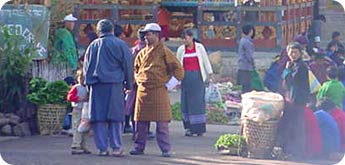Bhutan Info
Tour
Employment & Income

Although significant economic progress has taken place since the 1960s, the majority of the population remains dependent on agriculture for income and employment. Thae national per capita income stands at US$ 470 (1995). As most rural settlements are far from narkets, there has been little potential for the sale of surplus production of crops and livestock, although this is beginning to change with the opening of roads in the once inaccessible areas.The type of crops produced varies considerably, depending on climate of the farming system, are kept for draught power, milk and meat. Production of horticultural crops is increasing as their export potential has been realized. By 1995, Bhutan achieved 65% self sufficiency in food grains.
85% of the population derive a living from agriculture and other traditional activities in the rural sector. Employment in the modern development is as yet limited and does not provide significant employment. The government has been responsible for the establishment of several productive enterprises, but the private sector si being encouraged to take over these activities. Unlike many other developing countries, unemployment is not yet a major problem.






